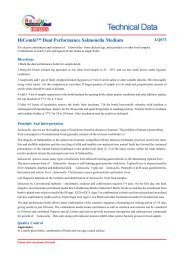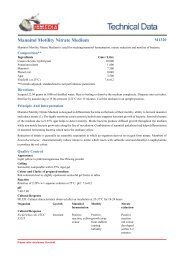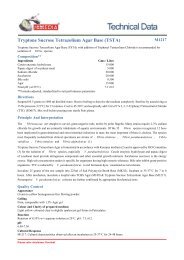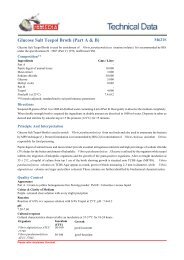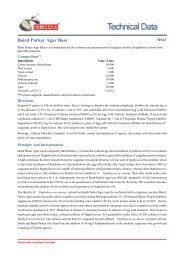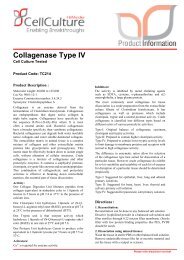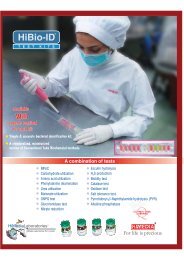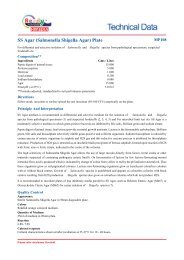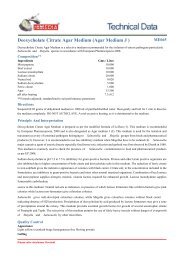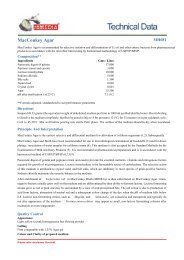SS Agar, Modified - HiMedia Laboratories
SS Agar, Modified - HiMedia Laboratories
SS Agar, Modified - HiMedia Laboratories
Create successful ePaper yourself
Turn your PDF publications into a flip-book with our unique Google optimized e-Paper software.
<strong>SS</strong> <strong>Agar</strong>, <strong>Modified</strong><br />
<strong>SS</strong> <strong>Agar</strong> (Salmonella Shigella <strong>Agar</strong>) <strong>Modified</strong> is used for the selective isolation and differentiation of Salmonella and<br />
Shigella species from pathological specimens, suspected foodstuffs etc.<br />
Composition**<br />
Ingredients Gms / Litre<br />
Beef extract 5.000<br />
Peptic digest of animal tissue 5.000<br />
Lactose 10.000<br />
Bile salts mixture 5.500<br />
Sodium citrate 10.000<br />
Sodium thiosulphate 8.500<br />
Ferric citrate 1.000<br />
Brilliant green 0.00033<br />
Neutral red 0.025<br />
<strong>Agar</strong> 12.000<br />
Final pH ( at 25°C) 7.2±0.2<br />
**Formula adjusted, standardized to suit performance parameters<br />
Please refer disclaimer Overleaf.<br />
M1032<br />
Directions<br />
Suspend 57.02 grams in 1000 ml distilled water. Heat to boiling with frequent agitation to dissolve the medium completely.<br />
DO NOT AUTOCLAVE OR OVERHEAT. Overheating may destroy the selectivity of the medium. Cool to about 50°C. Mix<br />
and pour into sterile Petri plates.<br />
Principle And Interpretation<br />
Salmonella and Shigella are gram-negative, facultatively anaerobic, non-sporulating rods in the family<br />
Enterobacteriaceae . They are widely distributed in animals, infecting mainly the stomach and the intestinal tissues. <strong>SS</strong> <strong>Agar</strong> is<br />
recommended as differential and selective medium for the isolation of Salmonella and Shigella species from pathological<br />
specimens (1) and suspected foodstuffs (2, 3, 4, 5) and for microbial limit test (6). <strong>SS</strong> <strong>Agar</strong> is a moderately selective medium<br />
in which gram-positive bacteria are inhibited by bile salts, brilliant green and sodium citrate.<br />
Peptic digest of animal tissue and beef extract provide essential growth nutrients. Lactose is the fermentable carbohydrate.<br />
Brilliant green, bile salts and thiosulphate selectively inhibit gram-positive and coliform organisms. Sodium thiosulphate is<br />
reduced by certain species of enteric organisms to sulphite and H2S gas. This reductive enzymatic process is attributed to<br />
thiosulphate reductase. Production of H2S gas is detected as an insoluble black precipitate of ferrous sulphide, formed upon<br />
reaction of H2S with ferric ions or ferric citrate, indicated by black centered colonies.<br />
The high selectivity of Salmonella Shigella <strong>Agar</strong> allows the use of large inocula directly from faeces, rectal swabs or other<br />
materials suspected of containing pathogenic enteric bacilli. On fermentation of lactose by few lactose-fermenting normal<br />
intestinal flora, acid is produced which is indicated by change of colour from yellow to red by the pH indicator neutral red.<br />
Thus these organisms grow as red-pigmented colonies. Lactose non-fermenting organisms grow as translucent colourless<br />
colonies with or without black centers. Salmonella species exhibit colourless colonies with black centers resulting from H2S<br />
production. Shigella species form colourless colonies, which do not produce H2S. While using samples suspected of being<br />
exposed to treatments that might have damaged the viability of microorganisms due to processing of food materials or samples<br />
from patients under antibiotic treatment etc., previous enrichment in Selenite cystine Broth Base (M025) or Tetrathionate Broth<br />
Base (M032) is necessary. Inoculate <strong>SS</strong> <strong>Agar</strong> plates with the enriched culture. After incubation the suspicious colonies should<br />
be subcultured on differential media to be identified biochemically or serologically.<br />
It is recommended to inoculate plates of less inhibitory media parallel to <strong>SS</strong> <strong>Agar</strong>, such as Hektoen Enteric <strong>Agar</strong> (M467) or<br />
Deoxycholate Citrate <strong>Agar</strong> (M065) for easier isolation of
<strong>HiMedia</strong> <strong>Laboratories</strong> Technical Data<br />
Shigella species (7).<br />
Quality Control<br />
Appearance<br />
Light yellow to pink homogeneous free flowing powder<br />
Gelling<br />
Firm, comparable with 1.2% <strong>Agar</strong> gel<br />
Colour and Clarity of Prepared Medium<br />
Reddish orange coloured clear to slightly opalescent gel forms in Petri plates<br />
Reaction<br />
Reaction of 5.7% w/v aqueous solution at 25°C. pH : 7.2±0.2<br />
pH<br />
7.00-7.40<br />
Cultural Response<br />
M1032: Cultural characteristics observed after an incubation at 35-37°C for 18-24 hours.<br />
Organism Inoculum<br />
(CFU)<br />
Please refer disclaimer Overleaf.<br />
Growth Recovery Colour of<br />
colony<br />
Escherichia coli ATCC 50-100 fair 20-30% pink with bile<br />
25922<br />
precipitate<br />
Enterobacter aerogenes<br />
ATCC 13048<br />
50-100 fair 20-30% cream pink<br />
Enterococcus faecalis ATCC 50-100<br />
29212<br />
none-poor =50% colourless with<br />
ATCC 12011<br />
black centre<br />
Salmonella Typhi ATCC 50-100 good-luxuriant >=50% colourless with<br />
6539<br />
black centre<br />
Salmonella Typhimurium 50-100 good-luxuriant >=50% colourless with<br />
ATCC 14028<br />
black centre<br />
Salmonella Enteritidis ATCC50-100<br />
good-luxuriant >=50% colourless with<br />
13076<br />
black centre<br />
Shigella flexneri ATCC<br />
12022<br />
50-100 good 40-50% colourless<br />
Storage and Shelf Life<br />
Store below 30°C in tightly closed container and the prepared medium at 2 - 8°C. Use before expiry date on the label.<br />
Reference<br />
1. Murray P. R., Baron J. H., Pfaller M. A., Jorgensen J. H. and Yolken R. H., (Eds.), 2003, Manual of Clinical Microbiology,<br />
8th Ed., American Society for Microbiology, Washington, D.C. ,,<br />
2. Downes F. P. and Ito K., (Eds.), 2001, Compendium of Methods for the Microbiological Examination of Foods, 4th Ed.,<br />
APHA, Washington, D.C.<br />
3. Wehr H. M. and Frank J. H., 2004, Standard Methods for the Microbiological Examination of Dairy Products, 17th Ed.,<br />
APHA Inc., Washington, D.C.<br />
4. Eaton A. D., Clesceri L. S., Rice E. W., and Greenberg A. W., (Eds.), 2005, Standard Methods for the Examination of Water<br />
and Wastewater, 21st Ed., APHA, Washington, D.C.<br />
5. Williams S., (Ed.), 2005, Official Methods of Analysis of the Association of Official Analytical Chemists, 19th Ed., AOAC,<br />
Washington, D.C.<br />
6. The United States Pharmacopeia, 2006, USP29/NF24, The United States Pharmacopeial Convention. Rockville, MD.<br />
7. MacFaddin J. F., 1985, Media for Isolation-Cultivation-Identification-Maintenance of Medical Bacteria, Vol. I, Williams<br />
and Wilkins, Baltimore.<br />
Revision : 1 / 2011
<strong>HiMedia</strong> <strong>Laboratories</strong> Technical Data<br />
Disclaimer :<br />
User must ensure suitability of the product(s) in their application prior to use. Products conform solely to the information contained in this<br />
and other related <strong>HiMedia</strong> publications. The information contained in this publication is based on our research and development work<br />
and is to the best of our knowledge true and accurate. <strong>HiMedia</strong> <strong>Laboratories</strong> Pvt Ltd reserves the right to make changes to specifications<br />
and information related to the products at any time. Products are not intended for human or animal diagnostic or therapeutic use but for<br />
laboratory, research or further manufacturing use only, unless otherwise specified. Statements contained herein should not be considered<br />
as a warranty of any kind, expressed or implied, and no liability is accepted for infringement of any patents.<br />
<strong>HiMedia</strong> <strong>Laboratories</strong> Pvt. Ltd. A-516,Swastik Disha Business Park,Via Vadhani Ind. Est., LBS Marg, Mumbai-400086, India. Customer care No.: 022-6147<br />
1919 Email: techhelp@himedialabs.com



